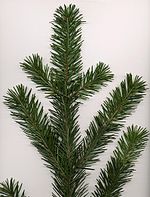Portal:Oregon/Selected article/66
The Coast Douglas-fir (Pseudotsuga menziesii var. menziesii), a variety of Douglas-fir, is an evergreen conifer native to the coastal regions of western North America, from west-central British Columbia, Canada southward to central California, United States. In Oregon and Washington its range is continuous from the Cascades crest west to the Pacific Ocean. In California, it is found in the Klamath and Coast Ranges as far south as the Santa Cruz Mountains, and in the Sierra Nevada as far south as the Yosemite region. It occurs from near sea level along the coast to 1,800 metres (5,900 ft) in the Sierra Nevada. Further inland, Coast Douglas-fir is replaced by the related Rocky Mountain Douglas-fir (Pseudotsuga menziesii var. glauca). The specific name, menziesii, is after Archibald Menzies, a Scottish physician and rival naturalist to David Douglas, who first documented the tree on Vancouver Island in 1791. Trees 60–75 metres (197–246 ft) or more in height and 1.5–2 metres (4.9–6.6 ft) in diameter are common in old growth stands, and maximum heights of 100–120 metres (330–390 ft) with diameters up to 4.5–6 metres (15–20 ft) have been documented. The tallest living specimen is the "Doerner Fir", (previously known as the Brummit fir), 99.4 m tall, at East Fork Brummit Creek in Coos County, Oregon. In 1939, Oregon made the tree the official state tree.

